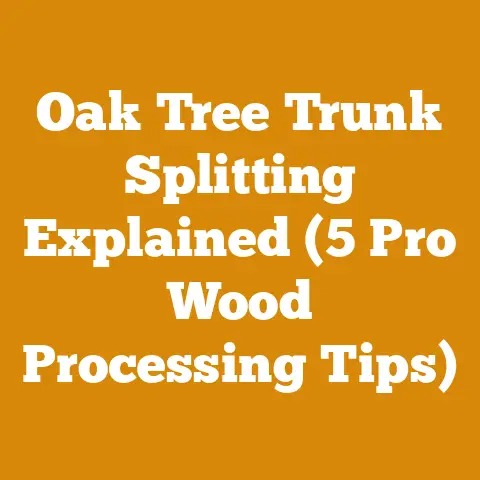Ryobi Chainsaw Chain Replacement (5 Pro Tips for Smooth Cuts)
Ryobi Chainsaw Chain Replacement: 5 Pro Tips for Smooth Cuts (and Keeping Costs Down!)
The buzz around chainsaws is growing, and not just because of the trees coming down. We’re seeing a surge in DIY wood projects, a renewed interest in sustainable heating with firewood, and a general push for self-sufficiency. But with all this cutting and chopping, one thing’s for sure: your chainsaw chain needs to be sharp! A dull chain isn’t just frustrating; it’s inefficient, dangerous, and can seriously dent your wallet. In this article, I’m going to focus on Ryobi chainsaws and share my top five tips for replacing your chain to ensure smooth cuts and keep your wood processing costs under control.
I’ve spent years felling trees, splitting wood, and generally wrangling timber. I’ve learned firsthand that a well-maintained chainsaw is your best friend – and a dull chain is a recipe for disaster. I remember one particularly cold winter when my firewood supply was dwindling. I tried to push through with a dull chain, thinking I could save a few bucks by delaying the replacement. Big mistake! It took me twice as long to cut each log, I burned through more fuel, and I nearly threw out my back in the process. That’s when I realized that a sharp chain isn’t just about convenience; it’s about efficiency, safety, and ultimately, saving money.
Understanding the Costs: More Than Just the Chain
Before diving into the pro tips, let’s talk about the real cost of a dull chain. It’s easy to focus on the price of a new chain (which, depending on the Ryobi model, can range from $15 to $40), but that’s just the tip of the iceberg.
- Increased Fuel Consumption: A dull chain forces your saw to work harder, guzzling more gas or draining your battery faster. I’ve seen fuel consumption increase by as much as 30% when using a dull chain. With gasoline prices fluctuating, that extra fuel adds up quickly. According to the U.S. Energy Information Administration (EIA), the average price of gasoline in the U.S. in recent years has varied considerably, but even a small percentage increase in fuel usage can have a noticeable impact over the course of a wood-cutting season.
- Increased Wear and Tear on Your Saw: A struggling chain puts undue stress on the engine or motor, shortening its lifespan. Repairs can be expensive, easily exceeding the cost of several new chains. I know a guy who burned out his electric Ryobi chainsaw trying to cut through a knotty oak log with a blunt chain. The repair bill was almost as much as a brand-new saw.
- Increased Labor Costs (If Applicable): If you’re paying someone to cut wood for you, a dull chain translates to more hours on the job, which means a higher bill. The average hourly rate for a skilled woodsman can range from $25 to $50, depending on location and experience. A dull chain could easily add an extra hour or two to a job, costing you a significant amount of money.
- Increased Risk of Injury: This is the most important cost of all. A dull chain is more likely to kick back, causing serious injury. According to the Consumer Product Safety Commission (CPSC), chainsaw-related injuries send tens of thousands of people to the emergency room each year. The medical bills and lost wages associated with an injury can be devastating.
- Lost Time and Frustration: Let’s face it, cutting wood with a dull chain is just plain miserable. It’s time-consuming, physically demanding, and incredibly frustrating. Time is money, and your sanity is priceless.
Therefore, proactively addressing chain replacement is not just about maintaining your Ryobi chainsaw, it’s about managing your overall wood processing budget.
Pro Tip #1: Identifying the Right Chain for Your Ryobi Model
This might seem obvious, but using the wrong chain is a common mistake. Ryobi chainsaws come in various models, each requiring a specific chain type. Using the wrong chain can damage your saw and void your warranty.
- Check Your Owner’s Manual: This is the first and most important step. Your owner’s manual will specify the correct chain type, including the pitch, gauge, and drive link count. Don’t guess!
- Locate the Stamp on Your Existing Chain: Many chains have the pitch and gauge stamped directly on the drive link. This is usually a small number like “3/8” or “.050”.
- Measure the Pitch: The pitch is the distance between any three consecutive rivets divided by two. You can use a ruler or a specialized chain pitch gauge. Common pitches for Ryobi chainsaws are 3/8″ and .325″.
- Measure the Gauge: The gauge is the thickness of the drive link where it fits into the guide bar groove. You can use a caliper to measure the gauge. Common gauges are .043″, .050″, and .058″.
- Count the Drive Links: The drive links are the small metal pieces that fit into the guide bar groove. Count them carefully. The number of drive links will vary depending on the length of your guide bar.
- Cross-Reference with Online Resources: Ryobi’s website and other online retailers often have chain compatibility charts that can help you find the right chain for your model.
Cost Considerations:
- OEM vs. Aftermarket Chains: Original Equipment Manufacturer (OEM) chains (Ryobi branded) are generally more expensive but are designed specifically for your saw. Aftermarket chains can be cheaper, but quality can vary. I’ve had good luck with some aftermarket brands, but I always research reviews carefully before buying. Expect to pay anywhere from $15-$40 for an OEM chain, while aftermarket chains can range from $10-$30.
- Chain Length and Type: The length of the chain depends on the length of your guide bar. Longer chains are generally more expensive. Also, different chain types (e.g., low-kickback, full chisel) can affect the price.
- Bulk Buying: If you use your chainsaw frequently, consider buying chains in bulk. You can often save money by purchasing multiple chains at once.
Example:
Let’s say you have a Ryobi RY40530 40V Brushless Chainsaw with a 16-inch bar. According to the owner’s manual, this model requires a chain with a 3/8″ pitch, .050″ gauge, and 56 drive links. You can then search for “Ryobi RY40530 chain replacement” online or at your local hardware store to find the correct chain.
Pro Tip #2: Mastering the Chain Replacement Process
Replacing a chainsaw chain isn’t rocket science, but it does require some basic knowledge and a few simple tools. Doing it yourself can save you money on labor costs and give you a better understanding of how your saw works.
- Gather Your Tools: You’ll need a chainsaw wrench (often included with the saw), gloves, and a clean workspace. A small brush or rag is also helpful for cleaning the guide bar.
- Disconnect the Power Source: For electric chainsaws, unplug the saw or remove the battery. For gas-powered chainsaws, ensure the engine is off and the spark plug is disconnected. This is crucial for safety.
- Loosen the Bar Nuts: Use the chainsaw wrench to loosen the bar nuts that hold the guide bar in place. Don’t remove them completely yet.
- Adjust the Chain Tension: Most Ryobi chainsaws have a chain tensioning mechanism. Use the wrench or a screwdriver to loosen the tension until the chain is slack enough to remove.
- Remove the Old Chain: Carefully remove the old chain from the guide bar and the sprocket.
- Inspect the Guide Bar: Before installing the new chain, inspect the guide bar for wear and damage. Look for burrs, uneven wear, or a bent bar. If the guide bar is damaged, it should be replaced. A worn guide bar will prematurely wear out your new chain.
- Clean the Guide Bar: Use a brush or rag to clean the guide bar groove. This will ensure that the new chain sits properly.
- Install the New Chain: Place the new chain around the sprocket and into the guide bar groove. Make sure the cutting edges of the chain are facing the correct direction (usually indicated by an arrow on the chain).
- Reinstall the Guide Bar: Place the guide bar back onto the saw, making sure the chain is properly seated in the groove.
- Tighten the Bar Nuts: Tighten the bar nuts finger-tight.
- Adjust the Chain Tension: Use the chain tensioning mechanism to adjust the chain tension. The chain should be snug but still able to be pulled around the guide bar by hand. A properly tensioned chain will have about 1/8″ of slack.
- Tighten the Bar Nuts Securely: Once the chain tension is correct, tighten the bar nuts securely.
- Test the Chain: Start the saw (following all safety precautions) and let it idle for a few seconds. Check the chain tension again and adjust if necessary.
Cost Considerations:
- DIY vs. Professional Replacement: Paying a professional to replace your chain can cost anywhere from $10 to $30 plus the cost of the chain. Doing it yourself is free (assuming you already have the tools), but it requires some time and effort.
- Guide Bar Maintenance and Replacement: A worn or damaged guide bar can significantly reduce the life of your chain. Guide bars can cost anywhere from $20 to $50, depending on the length and quality. Regularly maintaining your guide bar (filing off burrs, cleaning the groove) can extend its lifespan.
- Chain Tensioning Tools: While a chainsaw wrench is usually sufficient, some people prefer to use a specialized chain tensioning tool. These tools can make it easier to adjust the chain tension accurately.
My Experience:
I remember the first time I tried to replace a chainsaw chain. I didn’t bother reading the owner’s manual and ended up installing the chain backwards! It took me a while to figure out what I had done wrong, and I nearly stripped the threads on the bar nuts in the process. Lesson learned: always read the instructions!
Pro Tip #3: The Importance of Proper Chain Tension
Proper chain tension is crucial for safety, performance, and chain longevity. A chain that is too loose can come off the guide bar, while a chain that is too tight can overheat and break.
- Check Tension Regularly: Check the chain tension before each use and periodically during use. A new chain will stretch more than an older chain, so it’s important to check the tension frequently when using a new chain.
- Tension When Cold: Always tension the chain when it’s cold. As the chain heats up during use, it will expand, so a chain that is properly tensioned when cold will be slightly looser when hot.
- The “Pull-Around” Test: The best way to check chain tension is to pull the chain around the guide bar by hand. The chain should be snug but still able to be pulled around easily. There should be about 1/8″ of slack.
- Avoid Over-Tightening: Over-tightening the chain can cause excessive wear on the chain, guide bar, and sprocket. It can also make the saw harder to start and reduce its power.
- Adjust for Temperature: If you’re cutting wood in cold weather, you may need to adjust the chain tension slightly looser than you would in warm weather.
Cost Considerations:
- Premature Chain Wear: Improper chain tension is a major cause of premature chain wear. A chain that is too loose will bounce around and wear unevenly, while a chain that is too tight will overheat and stretch. Replacing chains more frequently adds to your overall costs.
- Guide Bar Damage: A chain that is too tight can also damage the guide bar, causing it to wear unevenly or bend. Replacing a guide bar can be expensive.
- Sprocket Damage: A worn or damaged sprocket can also cause chain problems. The sprocket is the toothed wheel that drives the chain. If the sprocket is worn, it can cause the chain to slip or bind. Replacing a sprocket can be a relatively inexpensive repair, but it’s still an added cost.
Data Point:
According to a study by Oregon Products, a leading manufacturer of chainsaw chains and guide bars, proper chain tension can extend the life of a chain by as much as 50%.
Pro Tip #4: Sharpening Your Chain: A Cost-Effective Alternative
Replacing your chain every time it gets dull can be expensive. Sharpening your chain is a cost-effective alternative that can significantly extend its lifespan.
- Learn to Sharpen Your Chain: Sharpening a chainsaw chain is a skill that every chainsaw owner should learn. It’s not difficult, and it can save you a lot of money.
- Use the Right Tools: You’ll need a chainsaw file, a file guide, and a depth gauge tool. A vise is also helpful for holding the guide bar steady.
- Maintain the Correct Angle: The file guide will help you maintain the correct angle when sharpening the chain. The correct angle will vary depending on the chain type.
- Sharpen Each Cutter Evenly: It’s important to sharpen each cutter evenly. Uneven sharpening can cause the chain to cut crookedly.
- Lower the Depth Gauges: As you sharpen the cutters, the depth gauges (the small metal tabs in front of each cutter) will become too high. Use the depth gauge tool to lower the depth gauges to the correct height.
- Consider an Electric Chain Sharpener: For those who don’t want to sharpen their chain by hand, an electric chain sharpener can be a good option. Electric chain sharpeners are faster and easier to use than hand files, but they can also be more expensive.
Cost Considerations:
- Sharpening Tools: A chainsaw file, file guide, and depth gauge tool can cost anywhere from $20 to $50. An electric chain sharpener can cost anywhere from $50 to $200.
- Time Investment: Sharpening a chain by hand takes time and effort. Electric chain sharpeners are faster, but they still require some setup and cleanup.
- Professional Sharpening: If you don’t want to sharpen your chain yourself, you can take it to a professional. Professional sharpening services typically cost around $10 to $20 per chain.
- Extending Chain Life: By sharpening your chain regularly, you can significantly extend its lifespan, saving you money on replacement chains. I’ve personally extended the life of my chains by at least 50% by sharpening them regularly.
Formula:
To calculate the potential cost savings of sharpening your chain, you can use the following formula:
- Cost of Replacement Chains per Year – Cost of Sharpening Supplies and Services per Year = Potential Cost Savings
Example:
Let’s say you typically replace your chainsaw chain three times per year at a cost of $30 per chain. That’s a total of $90 per year. If you invest in sharpening tools and supplies for $50 and sharpen your chain yourself, you can potentially save $40 per year.
Pro Tip #5: Maintaining Your Chainsaw: A Penny Saved is a Penny Earned
Regular chainsaw maintenance is essential for keeping your saw running smoothly and extending its lifespan. A well-maintained chainsaw will cut more efficiently, require fewer repairs, and last longer overall.
- Clean Your Saw Regularly: After each use, clean your chainsaw thoroughly. Remove sawdust and debris from the bar, chain, and engine or motor.
- Lubricate the Chain: Use a high-quality chain oil to lubricate the chain regularly. Chain oil reduces friction and wear, extending the life of the chain and guide bar.
- Check the Air Filter: A dirty air filter can restrict airflow to the engine or motor, reducing power and increasing fuel consumption. Check the air filter regularly and clean or replace it as needed.
- Inspect the Spark Plug: The spark plug is responsible for igniting the fuel in the engine. A fouled spark plug can cause the engine to run poorly or not start at all. Inspect the spark plug regularly and clean or replace it as needed.
- Store Your Saw Properly: When you’re not using your chainsaw, store it in a dry, protected location. Drain the fuel tank before storing a gas-powered chainsaw for an extended period of time.
Cost Considerations:
- Chain Oil: Chain oil can cost anywhere from $10 to $20 per gallon. Using a high-quality chain oil is worth the investment, as it will help to extend the life of your chain and guide bar.
- Air Filter and Spark Plug Replacement: Air filters and spark plugs are relatively inexpensive to replace. Replacing them regularly can help to keep your chainsaw running smoothly.
- Professional Maintenance: If you’re not comfortable performing chainsaw maintenance yourself, you can take it to a professional. Professional maintenance services typically cost around $50 to $100 per year.
- Preventing Costly Repairs: Regular chainsaw maintenance can help to prevent costly repairs down the road. A well-maintained chainsaw is less likely to break down, saving you money on repair bills.
Statistical Data:
According to a survey of chainsaw owners conducted by the National Arbor Day Foundation, those who perform regular chainsaw maintenance experience 25% fewer repairs and extend the lifespan of their saws by an average of two years.
My Personal Experience:
I’ve learned the hard way the importance of regular chainsaw maintenance. I once neglected to clean the air filter on my chainsaw for several months. As a result, the engine overheated and eventually seized up. The repair bill was hundreds of dollars. Now, I make sure to clean the air filter after every use, and I haven’t had any problems since.
Optimizing Costs: A Holistic Approach
Beyond these five pro tips, there are several other factors that can affect your overall wood processing costs.
- Wood Species: Different wood species have different densities and hardness levels. Cutting hardwoods like oak and maple will put more wear and tear on your chain than cutting softwoods like pine and fir. Consider the type of wood you’re cutting when budgeting for chain replacements. According to Forest2Market, a global provider of timber pricing data, hardwood prices are generally higher than softwood prices, reflecting their higher value and demand.
- Wood Quality: Knotty or dirty wood can also dull your chain faster. Try to avoid cutting wood that is heavily contaminated with dirt or rocks.
- Cutting Technique: Using proper cutting techniques can reduce the strain on your chain and extend its lifespan. Avoid forcing the saw through the wood, and let the chain do the work.
- Seasonality: Wood is often cheaper during certain times of the year. In many regions, firewood prices are lower in the spring and summer than in the fall and winter. Consider buying wood in bulk during the off-season to save money.
- Equipment Rental vs. Purchase: If you only need a chainsaw for occasional use, consider renting one instead of buying one. Renting can be a cost-effective option, especially if you don’t want to deal with the maintenance and storage of a chainsaw. The average daily rental rate for a chainsaw can range from $30 to $50, depending on the size and type of saw.
- Safety Gear: Don’t skimp on safety gear. A helmet, eye protection, ear protection, gloves, and chaps are essential for protecting yourself from injury. The cost of safety gear is a small price to pay compared to the potential cost of a serious injury.
- Permits and Regulations: In some areas, you may need a permit to cut wood on public land. Be sure to check with your local authorities before cutting any trees. Failure to obtain the necessary permits can result in fines and other penalties.
Actionable Takeaways
- Know Your Chain: Always use the correct chain for your Ryobi chainsaw model.
- Replace It Right: Master the chain replacement process to save on labor costs.
- Tension Matters: Maintain proper chain tension for safety and longevity.
- Sharpen Regularly: Learn to sharpen your chain to extend its lifespan.
- Maintain Your Saw: Keep your chainsaw clean and well-lubricated for optimal performance.
- Consider Wood Species and Quality: Choose your wood wisely to minimize wear and tear on your chain.
- Invest in Safety Gear: Protect yourself from injury with proper safety equipment.
Conclusion: Cutting Costs and Cutting Wood
Replacing a chainsaw chain may seem like a small task, but it can have a significant impact on your overall wood processing costs. By following these five pro tips, you can ensure smooth cuts, extend the life of your chain, and keep your Ryobi chainsaw running efficiently. Remember, a sharp chain is a safe chain, and a well-maintained chainsaw is a cost-effective chainsaw. So, get out there, cut some wood, and enjoy the fruits (or should I say, the firewood!) of your labor.
I hope this guide has been helpful. Remember, wood processing is a skill that takes time and practice to master. Don’t be afraid to experiment and learn from your mistakes. And always prioritize safety. Happy cutting!






